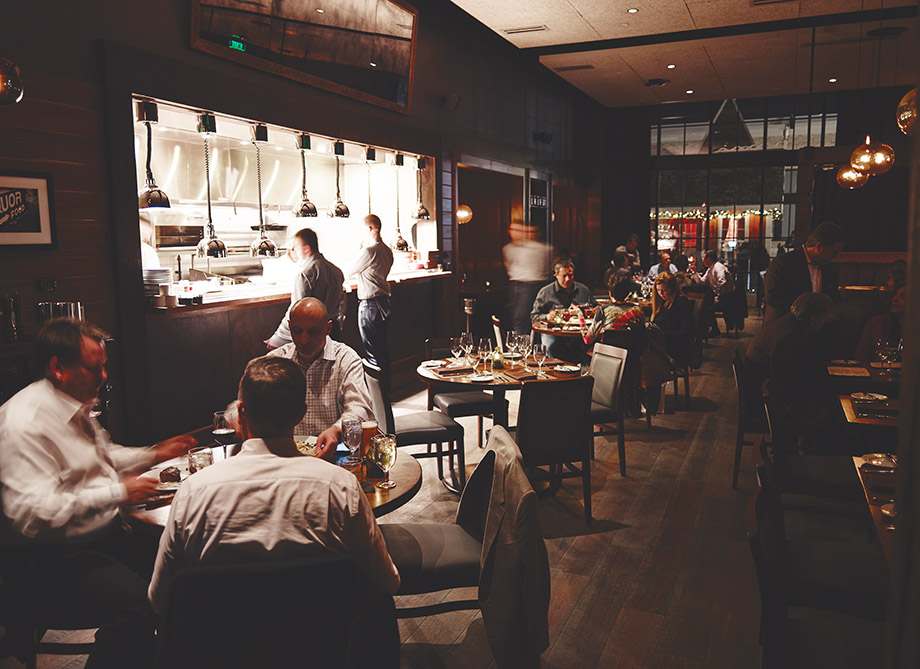
“Is it all perfect?” That was what our eager server kept asking at our second dinner at Oak Steakhouse. It was an unfair question, or at least unwise. A few months in, this ambitious new steakhouse in Avalon—the luxurious city-in-a-mall-in-a-suburb in Alpharetta—is so unpredictable that the truthful answer would have been, “Well, no, but a lot is pretty good, and a couple of things are really good.”
Perfection is an unreasonable standard in most restaurants, of course, even if you do get the sense that Oak Steakhouse, the debut Atlanta effort of a successful and longstanding restaurant group in Charleston, is aiming to play in the big leagues. Given the big-league prices it charges and the clientele it means to attract—neighbors who pay the stunning rents in the Avalon apartments—the standard should be pretty high. And it is, in the notably fresh vegetables, herbs, and salad greens the restaurant sources locally; in the elegance of one of the best foie gras appetizers I can remember tasting; and in the service that clearly means to win your repeat business.
It’s telling that the owners decided to open not ITP but in Avalon, a development that, like Atlantic Station (also owned by North American Properties), has been created as a kind of protected, unreal city. The casually plush restaurant—with distressed wood beams, high brown-leather banquettes, and a fleet of smiling servers uniformed in neat black-and-white check shirts and pressed denim—makes it seem like a country club, an impression reinforced by the card-dispensing, table-visiting, pomaded manager in jacket and carefully knotted tie.

johnny autry
As is often the case at steakhouses, the food ranks behind the clubbiness and service, both of which build and keep business. Where Oak aims to set itself apart from other steakhouses—as the genial, tall, bearded chef Chad Anderson will tell you if he comes by your table—is in its selling only Certified Angus Beef, all of it prime. Anderson, a native Atlantan, has steak cred: His first local restaurant job was at Buckhead’s New York Prime steakhouse, and he helped Kevin Rathbun open Rathbun’s a decade ago. CAB, as the menu calls the beef, is a consortium of thousands of ranchers who adhere to a set of standards that include marbling and tenderness to create brand identity and loyalty—and charge accordingly. If you order one of the four “classic steaks,” as I did the ribeye, the server will quickly ask, “Don’t you want the dry-aged?” It comes from the same New York company that dry-ages beef for Peter Luger, the landmark, cash-only steakhouse in Brooklyn. These days, beef lovers snobbishly insist on the higher, slightly gamy flavors of dry-aging, in which beef is hung for two months in carefully climate-controlled lockers with walls covered in carefully selected molds to encourage deep flavors—“cashew,” as the chef will describe them.
Sounds great in theory. But the dry-aged cuts are an average of $20 higher than the “wet-aged” cuts, meaning cuts vacuum-sealed for a few weeks in their own juices. Not that the wet-aged cuts are exactly cheap: Aside from a five-ounce carved tenderloin for $25, wet-aged cuts start at $39 for eight ounces of filet mignon and go up to $51 for New York strip. As for the running special of a “tomahawk” steak, a giant-sized bone-in ribeye named for the trimmed (“frenched”) bone like a hatchet handle, don’t ask. Or do: After the server tried to sell us on its voluptuous goodness, I inquired, “Is there anything else you want to tell us about it?” No, she said after a quick mental review of her checklist. “How much does it cost?” I prompted. “Oh—$130.” We passed.
In practice, the wet-aged handily beat the dry: Sixteen ounces of wet-aged, boneless ribeye for $49 had far more beef flavor, not to mention moistness and tenderness, than the 24-ounce bone-in, dry-aged ribeye for a whopping $85. True, dry-aging usually involves a trade-off of moistness and tenderness for flavor. But the bone should have helped make up for the juiciness—not to mention the melted butter the chef bastes every steak with during grilling.
By far the best steak was half the price of the others. For $25, the five-ounce tenderloin packed into its sane size more steak flavor—that charred-outside-tender-inside, know-it-when-you-taste-it umami flavor—than any other cut. Anderson calls it a way to use the smaller end of the tenderloin from which he cuts filet mignon. The chef is similarly resourceful with the rest of the tip that isn’t wide enough to serve on its own: The cooks hand-chop it to order for steak tartare, which they dress with olive oil, Dijon mustard, and minced salt-cured anchovies. The fresh and clean flavor of the meat survives the useless, unwelcome truffle oil.
Another way that Oak intends to distinguish itself from other steakhouses is by sourcing locally and seasonally (no Mexican asparagus, Anderson points out), and it does make a persuasive case for itself here. Seasonal vegetable salad was striking, a rectangular plate festively strewn with ribbons of turnips and radishes, chunks of beets, and startling magenta-rimmed halves of barely hard-boiled eggs pickled in beet juice. Another dish as fresh-tasting as it is pretty is the hamachi with batons of Granny Smith apples and peeled sections of blood orange, accompanied by thin slices of serrano and Fresno chiles.

Photograph by Johnny Autry
Sides of roasted vegetables are clearly fresh and seasonal, all of them moist from olive oil and butter. Yukon Gold potato puree, carefully riced and sieved, is fine but unmemorable. The sides are $8 and $10, and essential if you want anything with, say, a $49 steak, which brings the price of just the entree to what you might elsewhere pay for a dinner for two. Autumn root vegetables and cauliflower with Brussels sprouts are both irresistibly semi-blackened—but so heavily salted that, the first two nights, we felt compelled to resist them.
Then, on the third night, they were judiciously salted, and it was as if a fog had lifted. Lucky timing: That same night we opted for the entree described simply as “vegetarian option,” which is all the roasted vegetables on one plate, served over a puree (in this case fennel). It was also the night we tried the foie gras appetizer, served on a johnnycake with homemade cherry preserves—a small, elegantly conceived dish whose countrified expertise implied a simplicity much of the menu obscured. The relaxed crew of servers made Oak feel that evening like a different restaurant: a loose, fun one we’d gladly come back to.
Desserts can be subject to hyperbole; one server described them as “amazing” and “spectacular.” I’ll agree with him on the chocolate cake, or “giant hunk” as it’s called. And what a hunk it is: tender, high layers of dark chocolate cake filled with an espresso buttercream and a marvelous dark chocolate ganache that is torched briefly to make the chocolate bloom.
“Is it marvelous?” Our server asked one last time. Well, no, not everything. So the giant hunks of beef may not live up to the standards of that cake. But there are plenty of other things to like—and a discreet little piece of tenderloin I’ll be coming to Alpharetta for when I need a steak fix.
Rating ★ (good)
Vital Stats
950 Third Street, Alpharetta
678-722-8333
oaksteakhouseatlanta.com
Good to Know
Unlike the side-less steaks, the five-ounce tenderloin comes with pecorino-truffle frites—and it’s as good as the other steaks and half the price.
This article originally appeared in our February 2015 issue.













